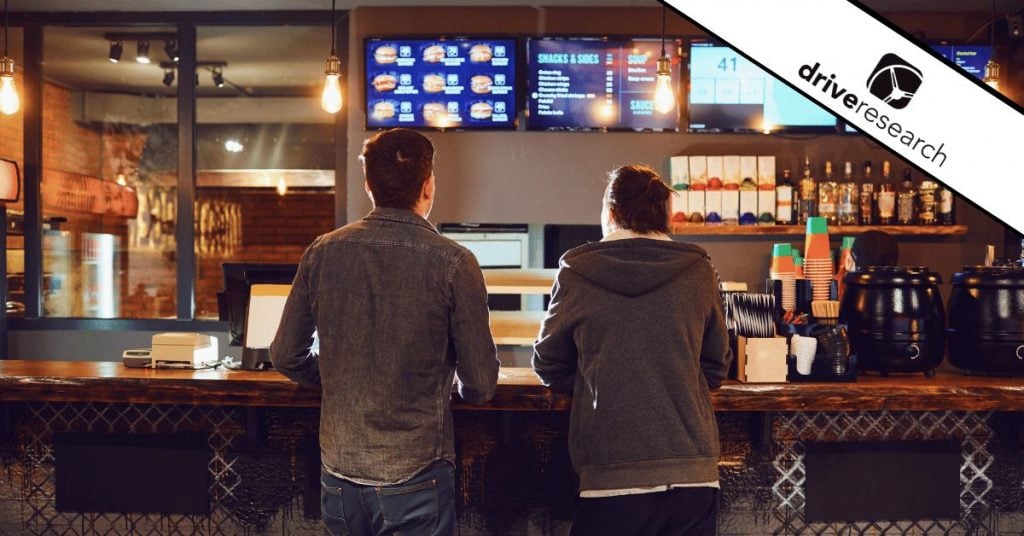
Wondering what it takes to successfully conduct customer intercept surveys for a chain restaurant? Drive Research is happy to help.
Intercept surveys are one of the best methodologies for collecting in-the-moment feedback. Customer intercept surveys or interviews serve as a valuable resource for building a customer experience strategy build on key data and insights – no guesswork.
The feedback from a customer intercept interview allows an organization to develop strategic brand messaging to encourage new business as well as understand what is or is not working for their current customer base.
Check out this post for an inside look at a recent project recently completed by our intercept survey company. While the full details about the project and report remain confidential with the sponsor of the study, this post offers a sneak peek into the customer intercept survey interview process.
Objectives
Our third-party market research firm was hired to conduct customer intercept surveys. The market research focused on a local restaurant.
The objectives of the study were refined during the kickoff meeting to address:
- Reason(s) that impact usage of the location
- Expected percent of the customer base to churn to a nearby competitive location
- Reason(s) for the churn
Another key objective of the restaurant intercept surveys was to create more defined customer profiles. The study would collect information such as age, where customers are coming from pre-visit, and where are they going post-visit.
The results helped the restaurant fuel the next steps in operations, marketing, and strategy.
Approach
To address the objectives at-hand, our restaurant market research company recommended using a customer intercept survey to collect feedback. Drive Research had permission from the client to be on-site at the location.
Intercept surveys are cost-effective, offer a quick turn-around, are measurable, and gather quality data. The combination of these four benefits creates a strong ROI for the client over other methodologies. A total of up to 10 to 15 questions were budgeted.
However, Drive Research encouraged the client to keep the survey length as short as possible to boost the total number of responses and data reliability.
If wanting to conduct a similar study but don’t have permission to be onsite to conduct intercept surveys, consider using geofencing surveys instead. More on that, here.
How were the intercept surveys collected?
The intercept surveys were completed via tablets using satellite 4G connections to the survey link. The survey was administered through a combination of self-administration and interviews:
- Self Administered: The customer would take the tablet and completing the survey privately
- Interviews: An onsite trained interviewer verbally asked questions to the customer and recorded the feedback
If having to choose between the two options, our intercept market research firm would suggest having an interviewer onsite. This option was preferred by research participants as customers could ask additional questions if clarification was needed.
Typically, an intercept survey study with an interviewer also yields higher quality data. If a participant is sticking to one or two-word answers, an interviewer can ask the customer to elaborate on their answers. This is not possible if a survey is taken privately.
How long did the intercept survey study take?
Although a 3-week minimum is typically required to schedule onsite interviewers, Drive Research was able to expedite fieldwork for the client by launching fieldwork less than two weeks after sign-off. The intercepts were conducted over four consecutive days during peak hours identified by the restaurant.
All shifts lasted a total of eight hours for a total of 32 hours of intercept surveying over the four days. Drive Research recommended intercepting customers during high-traffic times on these four days to capture the most significant percentage of a regular customer base as possible (combining both weekday and weekend days).
Customers were provided a coupon to the restaurant as a thank you for participating in the short survey.
Looking for tips on how to conduct intercept surveys? We’ve got your back!
Results
The survey took an average of 3 minutes to complete and included 8 questions. The survey received 497 responses. Drive Research provided daily progress reports to the client at the completion of each shift which highlighted the current number of completed surveys.
The level of responses far exceeded our estimated goal of 320 responses for the 4-days at the location. The 497 responses exceeded our estimates by 55%.
With a probabilistic sample, a total of 497 responses at the 95% confidence level offers a 4% margin of error. If the survey was conducted with another random pool of 497 customers at the store location, results would yield within +4% or -4% of the stated totals in the reports.
The margin of error can be used as a guideline to understand the high reliability of these results.
The intercept survey report included a topline summary of the findings, a PDF question-by-question charts, and an export of the line-by-line survey data collected. The report was delivered within 3 days of fieldwork ending.
Contact Drive Research
Drive Research is a national market research company located in New York. Our team has the knowledge and tools to design a robust intercept survey study for organizations in any industry, serving any audience.
Interested in receiving a proposal or estimate for an intercept survey study? Reach out today.



